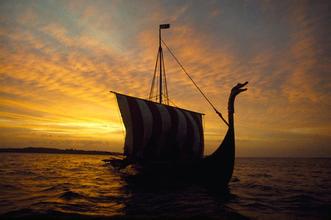Think you've got the Vikings pegged? With all the caricatures and stereotypes out there, there's probably a lot you've never heard about the seafaring Scandinavians who raided and settled coastal sites in the British Isles and beyond between the ninth and 11th centuries. Explore 10 surprising facts about the Vikings below.
你是否意識到“維京人”在你的思維中已經(jīng)被貼上了標簽?在漫畫和定式思維的影響下,關于這些在九世紀到十一世紀之間,侵略了大不列顛島以及更遠的一些鄰海地域,并在當?shù)囟ň拥木S京人,也許還有許多事實是你不知道的。下面,就讓我們一起探索關于維京人的10個驚人事實吧!

1. Vikings didn't wear horned helmets.
1. 維京人并沒有戴角盔的習慣
Forget almost every Viking warrior costume you've ever seen. Sure, the pugnacious Norsemen probably sported headgear, but that whole horn-festooned helmet look? Depictions dating from the Viking age don't show it, and the only authentic Viking helmet ever discovered is decidedly horn-free. Painters seem to have fabricated the trend during the 19th century, perhaps inspired by descriptions of northern Europeans by ancient Greek and Roman chroniclers. Long before the Vikings' time, Norse and Germanic priests did indeed wear horned helmets for ceremonial purposes.
忘掉你看到的每一套維京戰(zhàn)士服裝吧!當然,好戰(zhàn)的北歐人也許有戴帽子的習慣,但一定是綁有角的嗎?維京人時期的壁畫并沒有描繪這樣的角盔,而唯一所挖掘出來的真實頭盔是沒有角的。在古希臘人和羅馬編年史對古代北歐人所做的描述的影響之下,畫家們也許是對十九世紀的”潮流”進行了自由發(fā)揮。而遠早于維京人時期的挪威和日耳曼牧師們,的確會在儀式上戴角盔。
2. Vikings were known for their excellent hygiene.
2. 維京人對衛(wèi)生的注重遠近馳名
Between rowing boats and decapitating enemies, Viking men must have stunk to high Valhalla, right? Quite the opposite. Excavations of Viking sites have turned up tweezers, razors, combs and ear cleaners made from animal bones and antlers. Vikings also bathed at least once a week—much more frequently than other Europeans of their day—and enjoyed dips in natural hot springs.
除了駕船和斬首敵人,維京男人們就只能在瓦爾哈拉宮(塵世陣亡的英雄的住所)里發(fā)出惡臭?恰恰相反,在對維京人居住地的挖掘過程中,考古學家們發(fā)現(xiàn)了由動物骨頭和鹿角制作的鑷子、刮胡刀、梳子,以及耳勺。維京人每周至少沐浴一次--遠比同一時期的其他歐洲人頻繁得多--并且懂得享受純原生態(tài)的溫泉。
3. Vikings used a unique liquid to start fires.
3. 維京人用一種特殊的液體生火
Clean freaks though they were, the Vikings had no qualms about harnessing the power of one human waste product. They would collect a fungus called touchwood from tree bark and boil it for several days in urine before pounding it into something akin to felt. The sodium nitrate found in urine would allow the material to smolder rather than burn, so Vikings could take fire with them on the go.
維京人雖然是”潔癖怪人”,但他們卻能夠很好的利用人類所產生的廢物。維京人會從樹皮上收集一種叫做火絨的真菌,并在尿液中將火絨沸煮幾天,再將其捶打至與原來相似的物質。尿液中的硝酸鹽會使物質慢慢燃燒而不是迅速的燒盡,所以維京人可以持續(xù)的使用這種物質生火。
4. Vikings buried their dead in boats.
4. 維京人將尸體葬于船中
There's no denying Vikings loved their boats—so much that it was a great honor to be interred in one. In the Norse religion, valiant warriors entered festive and glorious realms after death, and it was thought that the vessels that served them well in life would help them reach their final destinations. Distinguished raiders and prominent women were often laid to rest in ships, surrounded by weapons, valuable goods and sometimes even sacrificed slaves.
無法否認,維京人極愛他們的船--以至于他們認為被葬在船里是一個極大的榮耀。在北歐地區(qū),勇敢的戰(zhàn)士們有資格進入榮耀之地,而他們生前所使用的戰(zhàn)船會送他們到最終的回歸之地。優(yōu)秀的戰(zhàn)士和杰出的女性常常在武器、珍貴的貨物,甚至是陪葬奴隸的圍繞下,安息于船中。
5. Vikings were active in the slave trade.
5. 維京人在奴隸交易中非常活躍
Many Vikings got rich off human trafficking. They would capture and enslave women and young men while pillaging Anglo-Saxon, Celtic and Slavic settlements. These “thralls,” as they were known, were then sold in giant slave markets across Europe and the Middle East.
許多維京人通過販賣人口致富。當他們入侵了盎格魯-撒克遜人(生活在大不列顛東部、南部)、凱爾特人或者斯拉夫人的居住地之后,會抓住當?shù)氐呐撕湍贻p男人作為奴隸。這些所謂的”奴隸”會被販賣于跨越歐洲和中東的巨大奴隸交易市場之中。
6. Viking women enjoyed some basic rights.
6. 維京女人們享有一些基本權利
Viking girls got hitched as young as 12 and had to mind the household while their husbands sailed off on adventures. Still, they had more freedom than other women of their era. As long as they weren't thralls, Viking women could inherit property, request a divorce and reclaim their dowries if their marriages ended.
維京女孩在12歲時就會”綁”住:嫁做人婦、在丈夫外出航行時看家。但她們相比同時代的女性有更多的自由。只要她們不是奴隸,維京女人就能夠繼承財富、主動提出離婚,并在婚約解除之時要求拿回她們的嫁妝。
7. Viking men spent most of their time farming.
7. 維京人生活中的大多數(shù)時間都在務農
This may come as a disappointment, but most Viking men brandished scythes, not swords. True, some were callous pirates who only stepped off their boats to burn villages, but the vast majority peacefully sowed barley, rye and oats—at least for part of the year. They also raised cattle, goats, pigs and sheep on their small farms, which typically yielded just enough food to support a family.
這也許是挺讓人失望的一件事,維京男人們最經(jīng)常使用的不是劍,而是鐮刀。沒錯,有些維京人的確是冷酷無情的海盜,只會燒殺搶奪,但大多數(shù)人還是在種植大麥、黑麥和燕麥——至少一年中總會有一段時間都在這樣做。他們也在自己的小農場中飼養(yǎng)牛、山羊、豬和綿羊,而這些常常只夠他們恰好養(yǎng)活一家人。
8. Vikings skied for fun.
8. 維京人以滑雪為樂
Scandinavians developed primitive skis at least 6,000 years ago, though ancient Russians may have invented them even earlier. By the Viking Age, Norsemen regarded skiing as an efficient way to get around and a popular form of recreation. They even worshipped a god of skiing, Ullr.
雖然古俄羅斯人比斯堪的納維亞人更早發(fā)明滑雪橇,但早在6000年前,斯堪的納維亞人(主要是指生活于古代北歐地區(qū)的人)已經(jīng)發(fā)展出了極其精美的滑雪橇。直到維京時期,北歐人們都把滑雪視為一種有效的交通方式,同時也是一種受歡迎的娛樂方式。他們甚至崇拜滑雪之神--烏勒尓。
9. Viking gentlemen preferred being blond.
9. 維京紳士們更偏好把頭發(fā)弄成淺色
To conform to their culture's beauty ideals, brunette Vikings—usually men—would use a strong soap with a high lye content to bleach their hair. In some regions, beards were lightened as well. It's likely these treatments also helped Vikings with a problem far more prickly and rampant than mousy manes: head lice.
為符合他們的審美觀,深棕色的維京人--通常是男性--會使用一種含有強堿性物質的肥皂漂白他們的頭發(fā)。在某些地區(qū),胡子也會被漂白。這種處理方式似乎能夠解決維京人原本頭發(fā)還是灰褐色時,無法控制且令他們無時無刻感到刺痛的難題:頭虱。
10. Vikings were never part of a unified group.
10. 維京人并非是一個集體
Vikings didn't recognize fellow Vikings. In fact, they probably didn't even call themselves Vikings: The term simply referred to all Scandinavians who took part in overseas expeditions. During the Viking Age, the land that now makes up Denmark, Norway and Sweden was a patchwork of chieftain-led tribes that often fought against each other—when they weren't busy wreaking havoc on foreign shores, that is.
維京人并不承認他們的同胞。事實上,也許他們根本不稱呼他們自己為維京人--特指所有參與海外征途的斯堪的納維亞人。在維京人時期,現(xiàn)在丹麥、挪威和瑞典組成的地域是由各個酋長領導的部落組成,當他們不再忙于在外國海岸燒殺搶奪時,他們就會相互入侵。
注:本文章轉載自前十網(wǎng),譯者張秋月












